#aof2020
Explore tagged Tumblr posts
Text
Aniplex Online Fest - How to Produce an Anime - Notes!
1:00 PM – 2:00 PM (PDT) | Aniplex Live Stream | Sunday 5 July 2020 Panel Description: Anime producers will talk about behind the scenes of anime production. Master of Ceremonies/Host: Hisanori Yoshida Guests: Shizuka Kurosaki (Aniplex, Producer) Masami Niwa (Aniplex, Producer), Atsushi Kaneko (A-1 Pictures, Producer), Toshikazu Tsuji (CloverWorks, Producer) _ Credit: Krow Smith |…

View On WordPress
0 notes
Text










Aniplex Online Fest (English) July.5.2020
SixTONES's Introduction
*NAVIGATOR || 'Fugou Keiji balance: unlimited' Opening theme
#SixTONES#fugou keji#NAVIGATOR#fugo keiji balance: unlimited#Jesse#kyomoto taiga#matsumura hokuto#tanaka juri#kochi yugo#my posts#YouTube#富豪刑事 balance:unlimited#morimoto shintaro#lol#AOF2020
15 notes
·
View notes
Text
I never realized ClairS was two people...
0 notes
Photo


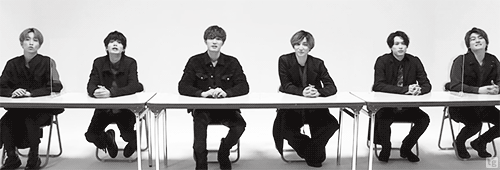
[AOF2020] The Millionaire Detective -Balance:UNMISSABLE
#SixTONES#fugou keiji balance: unlimited#the millionaire detective#miyano mamoru#onuki yusuke#Black and White
29 notes
·
View notes
Photo

【#AOF2020 海外特番】 日本国内の放送が開始しました。 #大貫勇輔 #宮野真守 松尾拓(プロデューサー)、鷲崎健(MC) アーティストコメント: #SixTONES 下記のリンクよりご視聴いただけます。 →https://youtube.com/watch?feature=youtu.be&v=UJ7SsUnTmbE&app=desktop ぜひ感想を #AOF2020 でツイートしてください。
17 notes
·
View notes
Photo

Jun Maeda said his upcoming new anime „The day I became a god“ will be the most heart-breaking of all time at #AOF2020 https://ift.tt/2Z0zWuk
0 notes
Text
Aniplex Online Fest - How to Produce an Anime - Notes!
1:00 PM - 2:00 PM (PDT) | Aniplex Live Stream | Sunday 5 July 2020
Panel Description: Anime producers will talk about behind the scenes of anime production. Master of Ceremonies/Host: Hisanori Yoshida Guests: Shizuka Kurosaki (Aniplex, Producer) Masami Niwa (Aniplex, Producer), Atsushi Kaneko (A-1 Pictures, Producer), Toshikazu Tsuji (CloverWorks, Producer)
_
Credit: Casea Mhtar | @madamekrow & Peggy Wood | @peggyseditorial
How Do You Produce An Anime?
Here’s the process for an anime: first proposal, the script, the storyboard, the key animation, painting, compositing, editing, and recording and that’s when it’s ready to be shown.
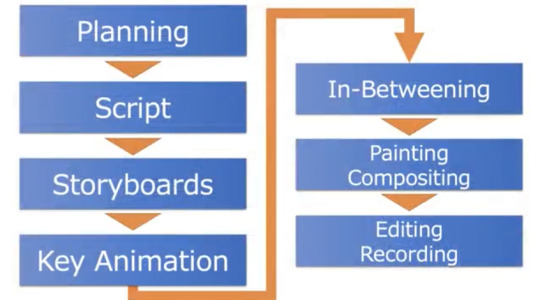
Step 1: Planning
There are mainly three different ways that proposals tend to come in during this planning stage. The first is when the publisher tells us about one of their hit products (games, a manga, etc.) and they ask us about adapting it into an anime. The second is when we find a series we like from a light novel or manga we’re reading already. Like, “Hey, this is cool!” Then we ask the publisher/get their permission to make the anime. The third is when a producer from an anime studio, or a director, or a staff member brings us something that they personally want to do. These are the most likely ways we come to a proposal for a new series and, of them, the third probably happens the most often.
Next comes the decision stage. A few more patterns emerge when we’re discussing whether to adapt or create an original series.
With originals, you are starting from scratch so the project is much more involved and time-consuming. Generally, a lot of staff members are involved and all of them want different things and, on top of that, the producer’s job is to make sure it does well. That it sells well, that it’s received well, that the team feels good or great about the project, and so on. So we have to find a way to respect everyone’s vision, while also guiding the project to profitability, which is pretty demanding. This also includes what I want to do as a producer. It’s fun to create something from scratch, but it also comes with so much risk. For example, originals don’t have a built-in fanbase, they don’t have the same support.
Shizuka Kurosaki provides an anecdotal example of a series he started 8 years ago that he is still working on from time to time. According to him, the series is still nowhere close to being produced. It’s just a sign of how hard it is to get it all to come together, especially when things change as time goes on.
Adaptations are different but still tough and demanding. First, you have great source material. Naturally, there are fans of the source material with what they want for the original. When we depict it through anime, there are things that were fine in the source but have to be changed for animation. We are pretty sensitive about how the original’s fans would see the results of our decision-making. Needless to say, that is a struggle that we don’t face when creating an original anime.
One of the hardest parts about adaptations is that novels and manga, which are largely still images and text, as opposed to anime, which is video, all have different rules of depiction. And when the time comes for us to make changes, we’re presented with options. Depending on what the scene is, certainly, some viewers will say, “Why couldn’t you just stay faithful to the original?” However, there are also times when changing it to be more anime-like gives it a shot of energy absent from the printed version. There's really no right answer so the process is like groping around in the dark and hoping that you find what works.
Producers don’t tend to have a lot of free time and when they do, like Masami Niwa mentioned, it’s mostly spent on things that will help at work. For example, reading what’s trending in novels or manga, watching movies, and even other animes from other companies. While it may seem like entertainment and is often enjoyable, these all serve one’s work as a producer in the field.
Step 2: Scripting
Generally, a “scenario meeting” or script meeting is held first. It’s when we look at what a writer has come up with and plan out some “book reading time.” For adaptations, it means reading the source text(s). Additionally, the planning producers and animation producers hold these meetings where the discussions start with talking about the potential series and gathering the team/assembling our staff. We already have a director in place by the time we have the first script meeting. The script is only done once the staff, including the director, gathers and is written.
Live-action scripts have hardly any screen direction when compared to anime scripts. Anime scripts are packed full of exposition. In the case of live-action scripts, if it’s like an ordinary office story. You pretty much recreate normal life. Whereas in an anime script, even if it’s an ordinary office story, there might be an employee with mind-blowing supernatural abilities. To depict something that doesn’t exist in real life, you need screen direction. And in the eyes of someone from another industry, I think it would seem like a really complex script because of the sheer amount of detail regarding action, layout, and such.
Step 3: Storyboarding
The storyboard is drawn from the script. Normally, the director draws the storyboards. But since the number of episodes keeps increasing for TV series, lately we’re seeing several storyboard artists dividing the labor.
Here are some samples of storyboards from Saekano the Movie: Finale, one of Toshikazu Tsuji’s past projects shared with the panel:
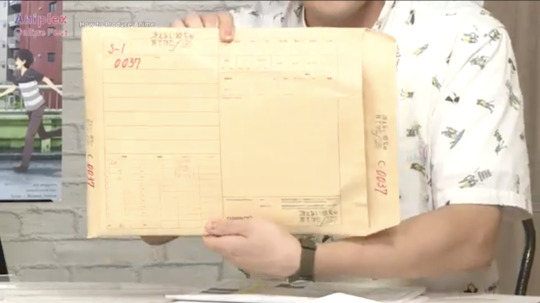
Envelopes like these, sometimes referred to as “shot envelopes” contain the layout drawings and artwork that become the key animations and in-betweens of individual scenes. By the end, all the materials that make up each scene and the finished ones are all inside one of these envelopes.
This is what storyboards look like:
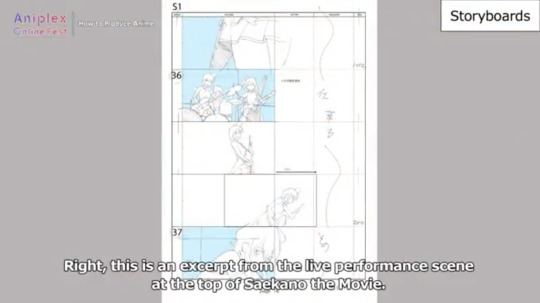
This is an excerpt from the live performance scene at the top of Saekano the Movie.
Using Saekano the Movie as an example--it was a tad difficult to associate the “live scene” of the script to the animation. In the script, the directors and team have endless discussions of what they want to see within however many seconds of the animation. This is described to the animators, the people who is actually drawing the actions/storyboards/etc., who only remember parts of the conversation or only get a few words and they have to create these complex drawings after hearing the phrase “live scene.” Sometimes there is a lot of direction in those discussions while in the original novel it may just say, “they fought, they won,” but the battle leads into an epic space war.
Producers are always excited to see the storyboards. They know it must be a lot of work, hard work, to get them but they’re amazing. Animators sometimes get mad at the scripts and the different “grammar” of the adaptations between the novel and the anime script, but they do great work. To the producers, it's almost the same feeling as a fan seeing the anime for the first time.
Back to the Saekano the Movie example, in the live performance scene above, the animator that was asked to draw the scene knew how to use the instruments being played. That experience is indispensable in some cases as it helps make the movements more accurate and realistic. In the worst case scenario, producers sometimes go with motion capture or use recordings of live performances that are then 3-D rendered for the key animations.
Step 4: Key Animations
Key animations are a part of the storyboard. They are often more detailed images used to depict specifics in individual scenes, with other frames used for movements happening in between. They are often discussed and detailed during and post conversations between the animator, director, super director, and the producer.
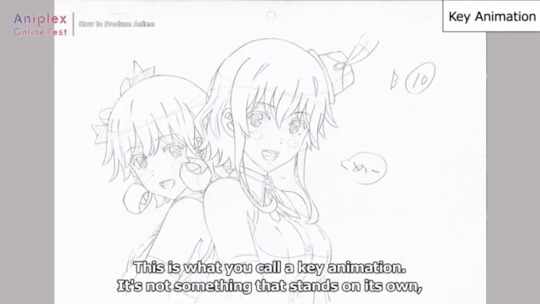
The above is an example of a key animation. It’s not something that stands on its own, rather, they’re made out of multiple drawings. This is where she utters the “meee” from the lyrics (Saekano the Movie). This key animation is to clarify that she’s saying “meee” from the lyrics as the shape of her mouth changes. The words on the page are helpful, but not necessary.
Next we see a sample of timesheets (image below).
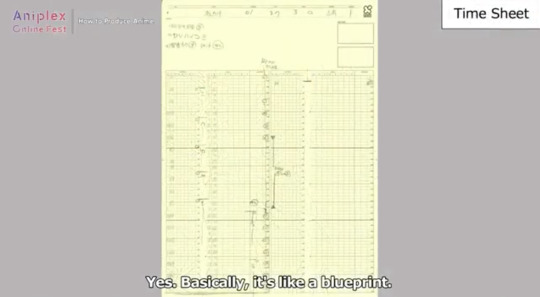
Time sheets are like a blueprint. This is a 3-second shot described in a timesheet and it contains all of the information going into that 3 seconds.
At the top of the timesheets are numbers and that’s where they write where they want the key animation positions to be. Since this is a live performance scene, it ends on a unique shot, and for normal shots, they’d insert some dialogue, or time a movement there. There are also instructions for Compositing. The timesheet is filled with all these details.
There are all kinds of key animations, and a key animation that’s cleared every step in the process is what we call an in-between.
Step 5: In-Betweening
In-betweening is creating the materials that fill up the spaces between the key animation positions. Since anime is all about movement from point a to point b, we have several pages to make characters and items move in-between the two points.

(Image from: https://boords.com/animatic/what-is-the-definition-of-an-animatic-storyboard)
The above is an example. On the left, you see and anamitc--which is essentially a storyboard shown in order to create the story. The frozen frames make up the key animations prior to details. On the right, you have the fully animated piece. All of the movement seen in-between those key animations seen on the left, come together to create the moving animation seen on the right is an example of the in-betweening discussed here.
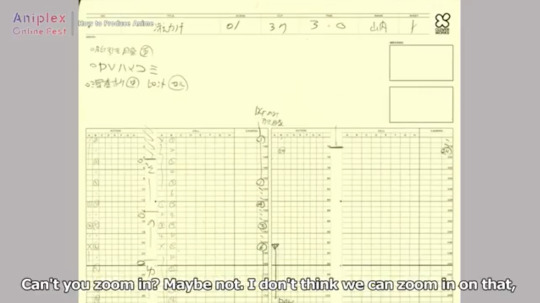
Going back to the time sheet--if you look closely you can see numbers going vertically which say 1-2-3-4 etc. Those are key animations. And the tiny dots you see in between, those are in-between animations. So drawing between the first and second key animations is the job of the in-between animator for this scene.
Step 5: Painting & Compositing
Next comes painting and composition--it’s where all the colors are applied. Years ago, this used to be done with real paint. Today though, this process is usually done digitally and it’s done for every frame (all of the in-betweens, key animations, etc.). The painting process includes Compositing. It’s not until after it’s been Composited that it’s truly finished.
During compositing, all of the different piece of paper shown in this panel so far are transformed into the animation you later see. Compositing gets the timesheet you just saw, with the materials for the backgrounds and cells, the animations and such, and then they work from that blueprint to create the full animation.
In the images seen above from the Saekano the Movie example, what you’ve seen is less than a single second but it took that much work to get there. As the producer, sometimes it’s your job to step in and help if the animators taking on that workload get overwhelmed.
Animators probably leave their personal mark somewhere on the key animations they create, something that only they know about. So if that storyboard can be thought of as a blueprint for drawing, then the key animations have their character settings, and they’re drawn by diverse people with unique intentions. That’s what we try to go for, and it’s really great to be able to see it all before anyone else as a producer. Like a character who’s never made a gesture like that in such a situation in the original story, but then when a certain animator draws that character, you’ll see that gesture and it will bring life to the image. If you start looking, it’s pretty endless. But seeing all these personal stamps is what makes it so intriguing. As long as it doesn’t stray far from the story, it’s not usually a problem for the producer. It what makes anime adaptation so enjoyable for one of the panelists.
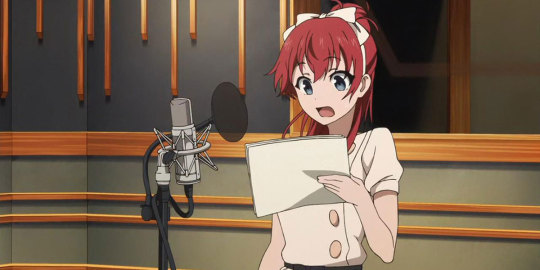
Final Step (6): Recording & Editing
After the visuals are done, comes the sound production and voice actors. Once you find the people for the roles needed, they move onto recording, and then background music is added, and finally you get the finished product that viewers see. Editing happens then too, though it also happens throughout the process as things are added and taken out over the course of production.
An example of the finished product:
youtube
The producer can change the whole feel of the show as they often make executive decisions on music, editing, marketing, etc. They have to oversee the process, as we’ve seen throughout the panelists’ discussion on the production process. It’s worth understanding from an analytic point of view as you see how their styles, focuses, and insight can influence the creation of a series.
3 notes
·
View notes
Text
The Summer of Online Anime Cons - Review!
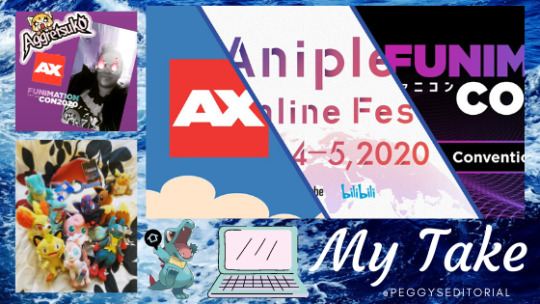
By: Peggy Sue Wood | @peggyseditorial
OKAY. This review has been way overdue, but in my defense, I wanted to wait until Summer was officially over, and for me, that meant the Crunchyroll Expo needed to happen before making this post. So let's get into it:
This summer, in addition to the Big Three Anime Weekend (where people could attend Anime Expo Lite, Funimation Con 2020, and Aniplex Online Fest all at once), we also had Comic-Con, the Virtual Crunchyroll Expo, and several other small conferences happening online like the Toonami special.
The events I "attended" happened to all be free (woohoo!), and to be perfectly honest: I LOVED it. I hope that they have more virtual conventions like these in the future. It's not because I don't love in-person and live conventions. I mean, anyone that knows me personally knows that I love conventions, traveling, dressing up, and more. I am a massive nerd for literary/professional/writing conferences and actively seek them out to attend throughout the year (if not present at them). I love anime conventions just as much and see them as a way to geek out with people from all over the world who share the same interests I do (and often know the niche anime/manga/webcomic/etc. that so few of my regular friends know about or have any interest in seeing!).
However, I think that Anime Expo has seriously fallen apart in recent years. It's something I've been more than vocal about in the past, like last year. Last year, as much as I did have fun, the convention space was overly crowded. AX is one of the largest anime conventions in the US, and overcrowding isn't unexpected given the size of it; however, since 2017, the convention has gone from simply full/crowded to claustrophobia-inducing. Enough so that someone like me, who had never felt claustrophobia before in their life, became overwhelmed and physically ill due to the number of people touching me on all sides as we attempted to shimmy down packed hallways. As a reference, I usually love enclosed and or crowded spaces--like, my mom and I frequented packed swap-meets as a child that I loved navigating. I also grew up with six older siblings, in a home next to Disneyland... so, like, crowds are not an issue for me, which is why I never expected to feel the level of anxiety I did in that horrible 2017 crowd, which repeated in AX 2019.
Add on to that panel experience: whereas before people could and would regularly slip in and out of panels with lines sometimes being outside the door for smaller rooms with more popular content, now the lines for most programs are often placed outside, in the heat, with attendees asked to line up sometimes hours in advance to have even a chance of attending. To my knowledge, Sakura-Con and several other conventions I've gone to in the last few years don't have that problem, and it's a fair guess as to why but let's leave that topic for another day.
By comparison, the virtual convention was a breeze! Yes, sometimes I had to sacrifice going to one panel over another, but who hasn't had to do that at conventions before? Ultimately, I could enjoy the panels from the comfort of my own home in PJs. I didn't need to worry about food, overheating in the sun, or finding the bathroom while at my house. I didn't get to meet new people (😥), but I did get to "attend" with friends of mine that can't go to conventions regularly for health reasons.
My major criticism of the virtual conventions can be summed up pretty easily. One issue I found was that the scheduling of three digital-conventions in one weekend was far too tight, but that was quickly mediated by the Funimation and Aniplex groups banding-together and merging the events so that Day 2 of FC2020 was a split with AOF2020. Another criticism I had is the lack of shopping--but I'm sure my wallet and bank account were relieved to find that I was much too entranced in panels to care about putting my cards through a ringer. I thought I would be upset by panel cancellations, but since virtual conventions are new and since panel cancellations happen at live conventions too, I can't say I'm all that upset by them. Not to mention how easy it was to handle such cancellations online when you have many more panels to attend freely.
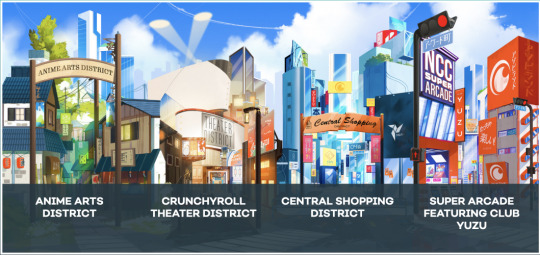
What was probably most upsetting was, at times, the layout. Of all the conventions, I think AX and Comic-Con did the best job with panel layout. AX used Twitch live streams, YouTube, and a handful of unique call-in panels that were easy to navigate. More frustrating was the ever-changing schedule times at AX, but that happens (mainly when you are one of the first conferences navigating the online-field and thereby making all the first mistakes). Ultimately, it was EASY to get to the right "room" for the right panel. It helped too that their schedule was frequently updated, so it was rarely a question of "which room?" and "when does this thing start?" Comic-Con, which featured all their panels on pre-scheduled youtube posts, was similarly easy to navigate and enjoy. Frankly, I preferred the use of YouTube as Comic Con's primary platform for distribution more, but that's just because I enjoy being able to go back and rewatch things later.
Funimation and Aniplex suffered a bit by not updating their schedules consistently. For example, Funimation kept listing panels for Day 2 in the room merged with the Aniplex Online Fest live-stream, leaving me (and I'm sure a few others) to wonder what in the world happened to all those disappearing panels. Though, I'm sad to say that Crunchyroll Expo had it way worse. Their different "rooms" attempted to allow for many panels and multiple languages, and it suffered due to the way they handled this, among other complications. The way things were labeled for different languages meant you either had to search through the individual tabs to make sure you wouldn't miss anything, or sift through all of it at once. There was no in-between. You also wouldn't know which panel was whereafter it aired, meaning things got lost easily. Sometimes I wouldn't even know what panel was canceled, rescheduled, or entirely overlooked by me! This issue is difficult for me to find acceptable, as the Crunchyroll Expo happened months after other conventions and had arguably more time to review platform options and layouts for their digital conference. It almost felt like they were aiming for a "different just to be different" feel ultimately at the cost of user experience, which is crazy since Crunchyroll is one of the largest online anime streaming platforms in the US abroad. It would have been better for them to publish their pre-recorded panels similar to episodes of a show that people could scroll through than the disorganized mess that their expo "stages" tried to do.
With that said, let’s focus on content.
Panels were the main focus of these conventions (obviously), and content-wise, they did NOT disappoint. AX hit HUGE on the industry panels from major licensing and publishing companies in the US and Japan. They also had the most in terms of interesting focuses. There was a healthy mix of fan panels, culture panels, industry panels, and such, meaning someone could find something of interest in nearly every hour. In fact, at the time, Casea (@madamekrow) and I were in a real panic about how to watch everything we wanted to watch. You could tell that a lot of thought had gone into making this thing work given how quickly they had to switch from live to digital, and I appreciate that. FC2020 and AOF2020, by comparison, were not as reliable in terms of those profession-based and fan-based panels, and given that they are mainly licensers of anime rather than convention planners, it makes sense. They were also up against a convention with a long history (BTW, AX celebrates 30 years in 2021). That's not to say they didn't come to the table without the cards.
FC2020 brought it home with premiere screenings of animes to come. My favorite of their premiere list is By The Grace of The gods, set to come out in October of 2020. Meanwhile, AOF2020 lacked premieres, professional and fan-based panels but made up for it with entertainment of a different kind. They hosted all-night marathons of popular works they license, held a digital concert, and unintentionally perhaps, generally gave a place to "chill" between the stressful jumping from panel to panel. In conclusion of the Big Three Weekend, they gave the summer a phenomenal start!
Next up is Comic-Con. In my opinion, their panels were heavily movie-based as opposed to print-media comics, manga, or anime. Yes, of course, there were plenty of comic panels too, but they weren't the same as what we saw during AX, FC2020, or AOF2020. The feel was different--maybe because of content. Regardless, it was interesting. I enjoyed much of the industry-related panels, like "Manga Publishing Industry Roundtable" and "How to Thrive as an Indie Comics Creator Now!" (I mentioned before I'm a publishing nerd, right?) Perhaps most preferable to me is that the Comic-Con panels are still available on their YouTube channel, which means that unlike many other conventions, I can share the panels with friends interested in a particular series, subject, or person. I LOVE that. Share-ability is huge, and I think Comic-Con was smart to make their content available moving forward. It has certainly been great for my film-loving friends and our team members here at The Anime View (like Jenna @jkmorgan-media).
Lastly, Crunchyroll Expo. What can I say about this one? The panels were huge variables. I know that everyone on our team found them to be a mixed bag, myself included, as Crunchyroll opened up to fans hosting panels. This was great, in my opinion, but with that comes a bit of criticism. Some fan panels were polished, exciting, and engaging. I loved many of the mecha panels. I also loved some that were engaging discussions of a topic between people that were close friends. HOWEVER, with that came just as many who were new to public speaking, hadn't prepared much of anything and just recorded an awkward Zoom call, or worse (it's hard to describe how).
As for the smaller conferences like the mini-Toonami Con during Adult Swim’s digital conference, I don’t really have anythings specific to say so I’ll be leaving them out of this review.
I don't want to shoot down any of the fans that hosted panels despite this negative review. It's HARD to present at conferences, and for some, it's even harder when they know they are being recorded. I remember my first conference where I stared at my paper the whole time and had to be asked to raise my voice twice for people to hear, while my friend aimed my phone at me to record the mortifying presentation for my mother. I don't blame the people that had a hard time doing this, and I fully support Crunchyroll for giving fans, particularly young ones, the platform and experience to do this. Some of those panels were very interesting, despite the presenter's awkwardness. Controversially, the handful that made no effort (and you could tell which), I don't extend that empathy.
For me, panels quality has nothing to do with camera work, lighting, or even sound in some cases (for the most part, as long as you can hear the words--awesome). I didn't need to see spot-on PowerPoint slides, anime clips to fit the conversation or hyperactivity. To me, it was all about what was being said or not said. One panel that comes to mind that I aimed to attend was about picking the right anime for you or a friend. I ended up ditching half-way through. It was, sorry to say, terrible. The hosts definitely had the energy and passion to discuss anime and interesting subjects beyond their approach to the idea of recommendations.
For example, they spent a reasonable amount of time comparing how they grew up experiencing anime to how many people now entering the fandom have come to know it. They started by describing how they watching anime on a handful of VHS rentals from BlockBusters, while many people in my (Peggy's) "anime generation" grew up in the age of fansubs and illegal uploads; meanwhile, my (Peggy's again) niece grew up experiencing all of her anime through legal online licensing services like Netflix, Funimation, Crunchyroll, etc. After discussing that difference, they mentioned briefly (as in one time in a single sentence) that the popularity of a particular genre in anime when you entered may affect what you find most interesting before completely undercutting themselves to say that you can't recommend anything to anyone because people always think about what they like first. (I hate to break it to them, but I find it pretty easy to recommend things based on my friends' stated interests in past series. Maybe that's because I watch almost everything of every genre in anime, but also--it's not rocket science. If your friend likes thrilling action movies, you can probably name a few thrilling action animes to satisfy their interest.) It felt as though the panel's title was misleading when the answer to recommending anime is "you can't." (when, in fact, you can with little to no complications!)
Overall, for me, AX takes the crown in terms of content. They had a fantastic mix of everything you hope to see at a comic convention in addition to making it fun. Comic-Con takes the crown for best platform use and layout (AX takes a close second and Aniplex/Funimation sharing third)... Crunchyroll doesn't rank in this category. Aniplex/Funimation shares the title of Best Entertainment. Crunchyroll takes the crown for fan inclusion into the presentation spotlight. They're all winners, but if I really had to rank them, it'd be this:
Anime Expo - Title: Content is King 👑
Comic-Con - Best Platform/Layout
Aniplex/Funimation (Sharing is caring) - Best Entertainment
Crunchyroll - Best Fan Inclusion
With that, I conclude my long drafted review. Thank you for your patience, and I'll see you all next week in another post!
#review#event#events#CRUNCHYROLL EXPO 2020#CRUNCHYROLL EXPO#CRUNCHYROLL#CRUNCHYROLL VIRTUAL EXPO#CRUNCHYROLL VIRTUAL EXPO 2020#CRX#crx2020#crx 2020#Virtual Crunchyroll expo#VCRX#vcrx 2020#vcrx2020#SAN DIEGO COMIC CON 2020#SAN DIEGO COMIC CON#COMIC CON 2020#SDCC2020#SDCC 2020#COMICCON@HOME#COMICCONATHOME#comic con#comic#comics#manga#anime#expo#anime expo#anime expo lite
1 note
·
View note
Video
youtube
[AOF2020]Kaguya-sama: Love Is War? Special Panel
0 notes
Video
youtube
[AOF2020]New Worldwide Contents by Sony Music Labels & by YouTube Music Channel
0 notes